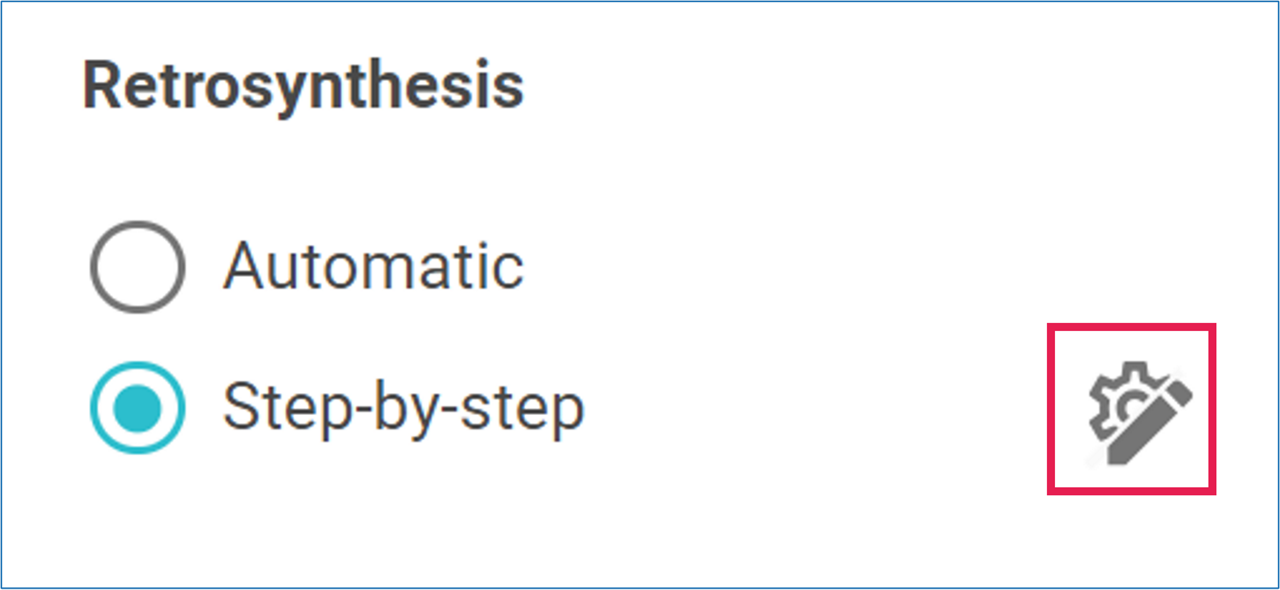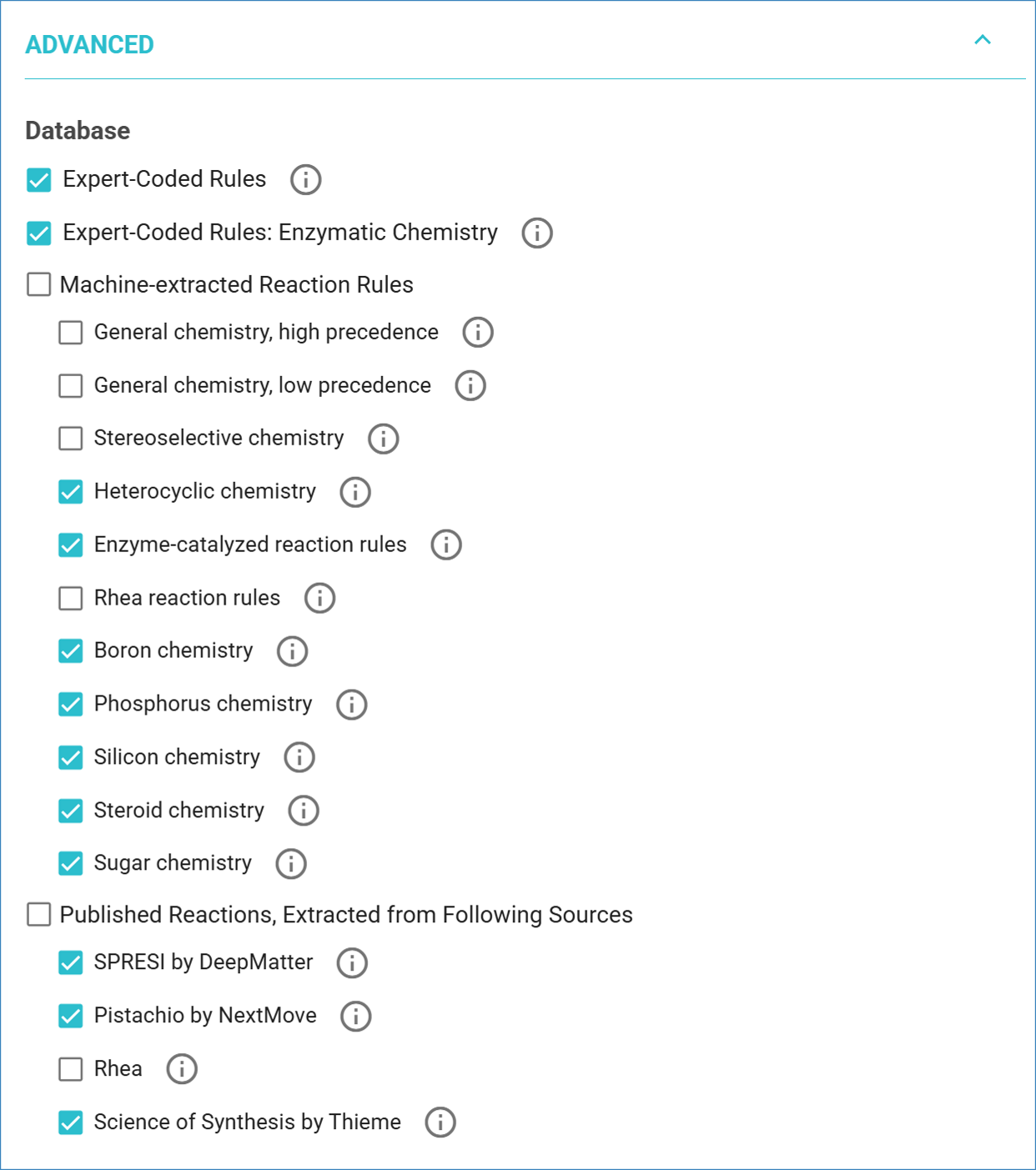Customize Analysis Parameters
You can configure your analysis by clicking the ‘Analysis Configuration’ icon.


Options
‘Options’ are useful “synthetic tricks” that can help tailor your analysis.

Allow Multiple Identical Retrosynthetic Disconnections in One Step
Look for multiple retrosynthetic disconnections that can be made in a single step. This filter is useful when the target molecule contains symmetry or multiple equivalent groups. For example, bis-alkylation of piperazine using ethyl iodide can be performed in one step, instead of sequentially.
Use for symmetric molecules and molecules with two or more identical motifs.
Start from Smaller Precursors
Eliminates precursors with higher molecular weights than the target compound.
Could be used to avoid ring contraction. Use carefully as some halide or boronic acid precursors could be heavier than the target compound.
Exclude Diastereoselective-only Reactions
Only show reactions that are enantioselective and eliminate any proposed reactions that are only diastereoselective.
For example: Catalytic hydrogenations of double bonds, Diels-Alder reactions, cyclopropanations.
Use when only one enantiomer is exclusively wanted.
Tip: The ‘Allow multiple identical retrosynthetic disconnections in one step’ option can be used for global deprotection of a molecule if multiple protecting groups are required, for example in sugar chemistry.
Advanced Path Ranking – Databases
SYNTHIA™ is built on our expert-coded rules database, which consists of over 100,000 reaction rules. These rules are based on transformations you would find in organic chemistry textbooks or in the literature and are written in a general way, so that they can be applied to any molecules, including novel ones. They consider full stereo- and regio-chemistry, and include protection information, reactivity conflicts, literature sources, and reaction conditions. By applying these rules to potential retrosynthetic disconnections, SYNTHIA™ will suggest reactions that are possible based on the chemistry that we know, and compatible with the rest of the molecule structure.
There is an additional subset of expert-coded rules based uniquely on enzymatic reactions, that can suggest enzymatic reactions as a green alternative to traditional chemistry.
Moreover, you can find five additional rules databases. They consist of machine-extracted rules, which cover specialized chemistries. They may be used to supplement the expert-coded rules database, particularly if your structure contains stereochemistry, complex aromatic systems, or unusual heterocycles. These rules were automatically extracted from the literature and may not contain all possible reaction condition incompatibilities, reactivity conflicts or protection requirements.
- General chemistry, high precedence: Reaction rules based on uncommon transformations that have a minimum of 10 published reaction examples.
- General chemistry, low precedence: Reaction rules based on rare transformations that have between 3 to 9 published reaction examples.
- Stereoselective chemistry: Reaction rules designed for stereoselective transformations.
- Heterocyclic chemistry: Reaction rules designed for the synthesis of aromatic heterocycles.
- Enzyme-catalyzed reaction rules: Reaction rules based on enzyme catalyzed reactions.
- Rhea reactions rules: Reaction rules extracted from the Rhea database of chemical and transport reactions of biological interest, which includes enzymatic reactions and transport reactions as well as reactions that occur spontaneously in biological systems, such as metabolic reactions.
- Boron chemistry: Reaction rules intended for introducing or substituting boron atoms.
- Phosphorus chemistry: Reaction rules intended for introducing or substituting phosphorus atoms.
- Silicon chemistry: Reaction rules intended for introducing or substituting silicon atoms.
- Steroid chemistry: Reaction rules based on commonly used chemistry for the syntheses of steroids.
- Sugar chemistry: Reaction rules based on commonly used chemistry for the syntheses of compounds containing sugars.
In addition to reaction rules databases, SYNTHIA™ also includes several databases of reactions that have been published in the literature.
- SPRESI by DeepMatter covers organic synthesis literature from 1974 to 2014, and contains 4.6 million chemical reactions abstracted from 700,000 references.
- Pistachio by NextMove includes over 10 million reactions sourced from patents filed with the United States Patent and Trademark Office (USPTO), the European Patent Office (EPO), and the World Intellectual Property Organization (WIPO), up to the year 2024.
- Rhea is an expert-curated database of biochemical reactions, that includes enzymatic reactions and transport reactions as well as reactions that occur spontaneously in biological systems, such as metabolic reactions.
>> Rhea - Science of synthesis provides full-text descriptions of organic transformations and synthetic methods as well as experimental procedures, that review synthetic methodology developed from the early 1800s to-date for the entire field of organic and organometallic chemistry. World-renowned experts have chosen the most important molecular transformations for a class of organic compounds and elaborated on their scope and limitations.
>> Science of Synthesis
By default, all expert-coded rules are enabled, along with the machine-extracted rules for Heterocyclic Chemistry, Enzyme-catalyzed Reaction Rules, Boron Chemistry, Phosphorous Chemistry, Silicon Chemistry, Steroid Chemistry, Sugar Chemistry, and the SPRESI, Pistachio, and Science of Synthesis databases.

.png)

